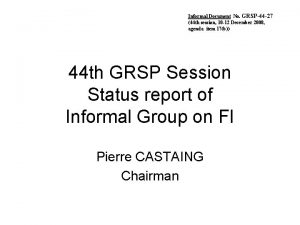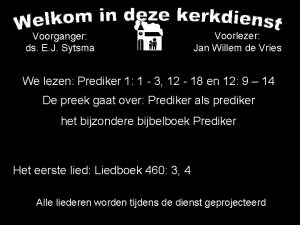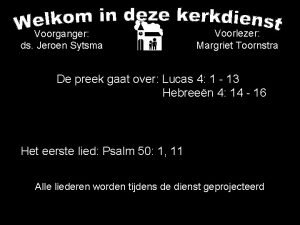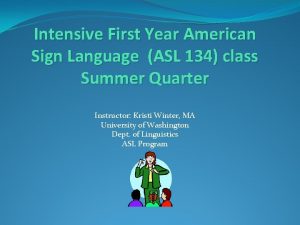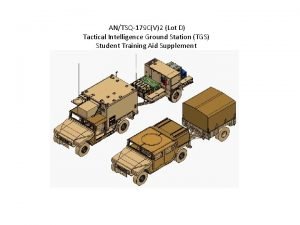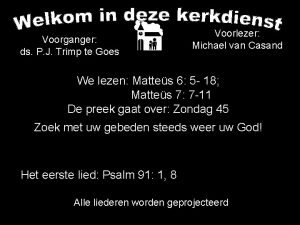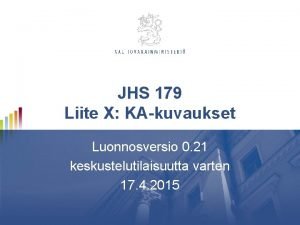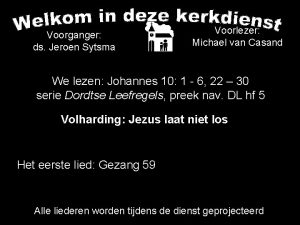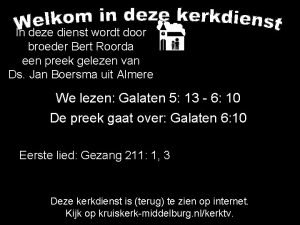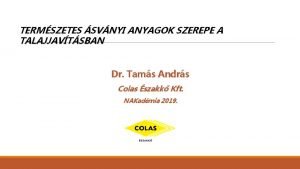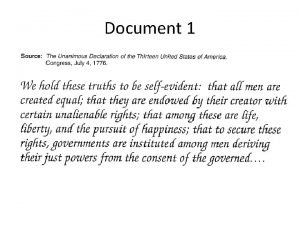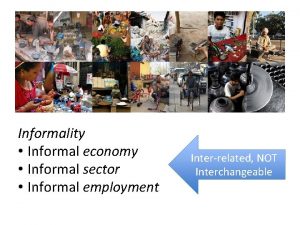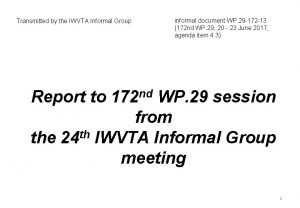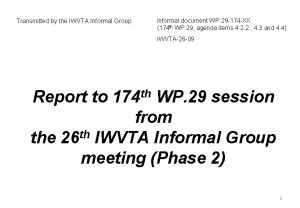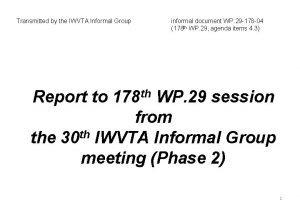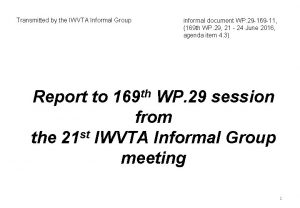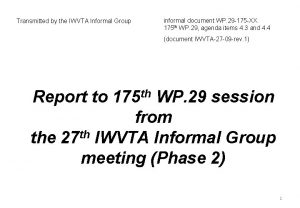Informal document WP 29 179 22 179 th














- Slides: 14

Informal document WP. 29 -179 -22 179 th WP. 29, 12 -14 November 2019, Agenda item 7 The Informal Working Group on Periodical Technical Inspections GENERAL OVERVIEW OF IN-SERVICE COMPLIANCE ASSESSMENT

GENERAL OVERVIEW OF IN-SERVICE COMPLIANCE ASSESSMENT

COMPLIENCE MANAGEMENT COMPLIENCE Identification of complience obligations and evaluating complience risks Planning to address complience risks and to achieve the objectives Operational planning and control of complience risks Performance evaluation and complience reporting Managing non-complience and continual improvement

PRINCIPLES OF IN-SERVICE COMPLIANCE ASSESSMENT Principles of in Service Compliance Enforcement a shift towards sustainability of transport systems, where all aspects of vehicle use need to be considered, including safety, the environment, mobility, efficiency, productivity and personal security INTEGRITY and COMPLIANCE are the basis and opportunity for a sustainable transport system UN Regulations consider the concept of continuous compliance third party assessment and inspection risk-analysis approach the increased complexity of vehicles and the need for them to be properly maintained throughout their life

PRINCIPLES OF IN-SERVICE COMPLIANCE ASSESSMENT Principles of in Service Compliance Enforcement the opportunities afforded by advanced onboard and off-board measurement systems to reduce the cost of compliance vehicle design and validation methods should demonstrate compliance a vehicle would be expected to perform during a normal operation vehicle self-diagnosis might play a role in continuous compliance, provided it is trustable and impartialon access, under well-defined and agreed preconditions, to the technical specifications of each individual vehicle and the data needed for objective verification of the functionality of the safety and environment related systems, whether or not the safety and environment-related systems are functioning

PRINCIPLES OF IN-SERVICE COMPLIANCE ASSESSMENT Principles of in Service Compliance Enforcement development of in service compliance vehicle assessment methods for periodical technical inspection and where appropriate, road side inspection role of roadworthiness inspections, including PTI, is to verify in-service vehicle compliance

COMPLIENCE ELEMENTS Co. P SAFETY In-Service Conformity Market Surveillance PTI/Roadside Inspection

LEGISLATION The 1958 Agreement National Legislation The 1997 Agreement Co. P In-Service Conformity Market Surveillance PTI/Roadside Inspection

INFORMATION FOR IN-SERVICE CONFORMITY In-Service Conformity Information from Type Approval Authority warranty claims Contracting Party surveillance testing warranty repair works recorded at servicing PTI/Roadside Inspection?

DURABILITY OF POLLUTION CONTROL (UN R 49) The tests for durability of pollution control devices undertaken for type approval and testing of conformity of inservice vehicles or engines are to be carried out 160, 000 km or five years, whichever is the sooner, in the case of engines fitted to vehicles of category M 1, N 1 and M 2 300, 000 km or six years, whichever is the sooner, in the case of engines fitted to vehicles of category N 2, N 3 with a maximum technically permissible mass not exceeding 16 tonnes and M 3 Class I, Class II and Class A, and Class B with a maximum technically permissible mass not exceeding 7. 5 tonnes 700, 000 km or seven years, whichever is the sooner, in the case of engines fitted to vehicles of category N 3 with a maximum technically permissible mass exceeding 16 tonnes and M 3, Class III and Class B with a maximum technically permissible mass exceeding 7. 5 tonnes.

CONSISTENCY OF THE 1958 AND THE 1997 AGREEMENTS There is the need to, within the work of GRs, explore the feasibility of introducing provisions, relevant for in-use requirements for vehicles, into the relevant UN Regulations.

CONSISTENCY OF THE 1958 AND THE 1997 AGREEMENTS PTI/Roadside Inspection can be the element of inservice conformity. In-use requirements for vehicles and test and inspection methods from the relevant UN Regulations are to be placed into UN Rules.

DEFINITIONS TO BE CLARIFIED in-service conformity in-service compliance DEFINITIONS vehicle normal in-service conditions vehicle normal useful life periodection

Thank you for your kind attention! 14

